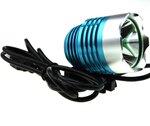If one desires maximum output, the Supernova M99 has an output of 1100 lumens on lowbeam, 1600 lumens on high beam, and its a true engineered, controlled headlight that will maximize the effectiveness of those lumens while being usable on public roads and paths without its compromising aim or the safety of others. Certainly the Seca is brighter, and fabulous for its intended use, but it isn't a controlled headlight, its an uncontrolled off road floodlight. It's important to make the distinction clear, as you point out one wouldn't want to have inadequate light off road, but likewise shouldn't misuse one that would be negligent to use on public roads.While I understand you think my info is outdated, its not. What is the difference between our thinking is how bright, the light focus and beam. Generally these lights are great for simple riding. Down a dark street or path these lights with an output of 1200 lumins or less is reasonable. On a dark trail or fire road you may find quickly these light are not enough dependant on how fast your going and the terain your incountering. Many of these lights pattern is focused with a small pattern. The average power these lights sees is not that much. I think Bosch and Yamaha are using 7.6 volts to produce the light. While my seca 2000 is 2000 lumins, likely on high beam. It pretty much overkill on a bike path, even on low beam. I tend to face it more downward because of that fact, when I ride the bike path with my wife. I have connected these wired lights on several models of ebikes. I know how difficult they are to install and the weak points of the installation. The motorcycle reference doesn't mean that much. One because most motorcycles on the road don't use LED bulbs. Also the beam is much wider on a motorcycle. So like I said, its a difference in point of view based on what you would be using the light for.
As a daily commuter averaging 150 miles a week on busy roads during rush hour , often in the dark and rain, lighting is very important to me, therefore I have put a lot of thought and research into my choices. I use a Busch & Muller IQ-X E headlight wired to the light circuit which needed nothing more than crimping on 2 connectors to plug into the light circuit. At 48v 7w 150 lux, Its approximately 500-600 lumen equivalent, the beam is wider than a typical 2 lane road. Its all that's needed for better than 95% of my rural , suburban, and urban riding. When I need a little more light, I have a Specialized Flux Expert which is also a true controlled headlight that can be aimed correctly without compromise. It has a 2 level 400-800 lumen low beam, and a 2 level 600-1200 highbeam which is excellent in off road conditions.
